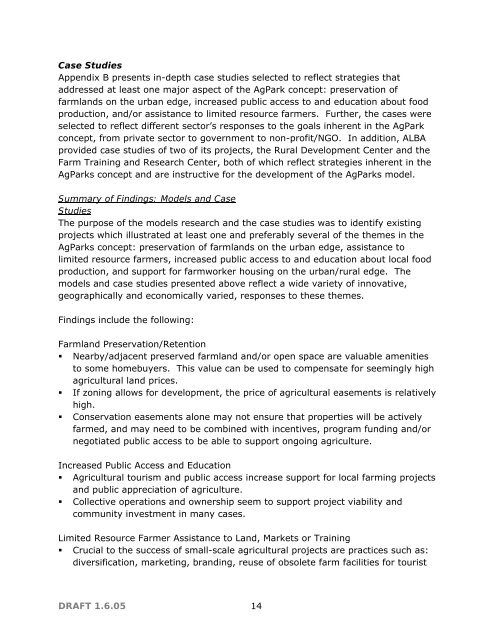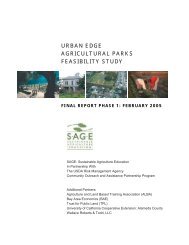A Feasibility Study for Urban Edge Agricultural Parks - SAGE
A Feasibility Study for Urban Edge Agricultural Parks - SAGE
A Feasibility Study for Urban Edge Agricultural Parks - SAGE
You also want an ePaper? Increase the reach of your titles
YUMPU automatically turns print PDFs into web optimized ePapers that Google loves.
Case StudiesAppendix B presents in-depth case studies selected to reflect strategies thataddressed at least one major aspect of the AgPark concept: preservation offarmlands on the urban edge, increased public access to and education about foodproduction, and/or assistance to limited resource farmers. Further, the cases wereselected to reflect different sector’s responses to the goals inherent in the AgParkconcept, from private sector to government to non-profit/NGO. In addition, ALBAprovided case studies of two of its projects, the Rural Development Center and theFarm Training and Research Center, both of which reflect strategies inherent in theAg<strong>Parks</strong> concept and are instructive <strong>for</strong> the development of the Ag<strong>Parks</strong> model.Summary of Findings: Models and CaseStudiesThe purpose of the models research and the case studies was to identify existingprojects which illustrated at least one and preferably several of the themes in theAg<strong>Parks</strong> concept: preservation of farmlands on the urban edge, assistance tolimited resource farmers, increased public access to and education about local foodproduction, and support <strong>for</strong> farmworker housing on the urban/rural edge. Themodels and case studies presented above reflect a wide variety of innovative,geographically and economically varied, responses to these themes.Findings include the following:Farmland Preservation/Retention• Nearby/adjacent preserved farmland and/or open space are valuable amenitiesto some homebuyers. This value can be used to compensate <strong>for</strong> seemingly highagricultural land prices.• If zoning allows <strong>for</strong> development, the price of agricultural easements is relativelyhigh.• Conservation easements alone may not ensure that properties will be activelyfarmed, and may need to be combined with incentives, program funding and/ornegotiated public access to be able to support ongoing agriculture.Increased Public Access and Education• <strong>Agricultural</strong> tourism and public access increase support <strong>for</strong> local farming projectsand public appreciation of agriculture.• Collective operations and ownership seem to support project viability andcommunity investment in many cases.Limited Resource Farmer Assistance to Land, Markets or Training• Crucial to the success of small-scale agricultural projects are practices such as:diversification, marketing, branding, reuse of obsolete farm facilities <strong>for</strong> touristDRAFT 1.6.05 14





